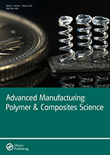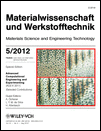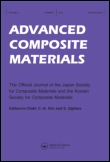
Journal of Composites Science
Scope & Guideline
Innovating the Future of Composites Science
Introduction
Aims and Scopes
- Composite Material Development:
Focuses on the synthesis, processing, and optimization of composite materials, including polymer-based, metal matrix, and ceramic composites. This includes innovations in manufacturing techniques such as additive manufacturing and advanced molding processes. - Mechanical and Physical Properties:
Investigates the mechanical, thermal, and electrical properties of composites, including the effects of various reinforcements and fillers on these properties, as well as their performance under different environmental conditions. - Sustainability and Recycling:
Explores sustainable practices in composite materials, including the use of bio-based materials, recycling of composites, and the development of eco-friendly composites. This includes research on waste valorization and the life cycle assessment of composite materials. - Multifunctional Applications:
Examines the applications of composite materials in diverse fields such as automotive, aerospace, biomedical, and construction. This includes studies on the integration of smart functionalities and performance enhancements in composite materials. - Modeling and Simulation:
Utilizes computational methods and simulations to predict the behavior of composite materials under various loading conditions. This includes finite element analysis and machine learning approaches to optimize composite designs.
Trending and Emerging
- Bio-based and Sustainable Composites:
There is a significant increase in research focusing on bio-based composites and sustainable practices, highlighting the importance of eco-friendly materials that reduce environmental impact. - Nanocomposites and Advanced Materials:
The incorporation of nanomaterials into composites is gaining traction, with research exploring the unique properties and enhanced performance of nanocomposite systems. - Smart and Multifunctional Composites:
Emerging research emphasizes the development of smart composites that can respond to environmental stimuli, integrating functionalities such as self-healing, sensing, and energy harvesting. - Additive Manufacturing Techniques:
The use of additive manufacturing for composite material fabrication is trending, particularly in producing complex geometries and tailored properties for specific applications. - Recycling and Circular Economy in Composites:
Research on recycling composite materials and developing circular economy approaches is on the rise, focusing on sustainable end-of-life solutions for composite products.
Declining or Waning
- Traditional Fiber Reinforcement Techniques:
Research focusing solely on traditional fiber reinforcement techniques is becoming less common, as newer methods and materials, including hybrid and multifunctional composites, gain popularity. - Single Material Applications:
The trend towards multi-material and hybrid composites is overshadowing studies that focus exclusively on single-material applications, reflecting a shift towards more complex and functional composite systems. - Conventional Mechanical Testing Methods:
There is a noticeable decrease in studies relying solely on conventional mechanical testing methods, with a growing emphasis on advanced characterization techniques and computational modeling. - Static Load Analysis:
Research centered on static load analysis of composites is declining, as dynamic and fatigue behavior studies become increasingly relevant in the context of real-world applications.
Similar Journals

International Journal of Polymer Science
Innovating the Future of Polymer ScienceInternational Journal of Polymer Science is a prominent and peer-reviewed journal dedicated to advancing the field of polymer science. Published by Hindawi Ltd, this open-access journal has been making significant contributions to the discipline since its inception in 2009, ensuring that research findings are accessible to a global audience. With an impressive impact factor and positioned in the Q2 quartile for Polymers and Plastics as of 2023, it ranks 46th out of 161 in the Scopus database, reflecting its strong standing in the research community. The journal welcomes innovative research across various topics within polymer science, including synthesis, characterization, and applications in diverse industries. By providing a platform for scholars, professionals, and students, the International Journal of Polymer Science not only encourages the dissemination of knowledge but also fosters collaboration and innovation in this essential field. Based in Egypt and operating under a rigorous selection process, it remains a vital resource for anyone involved in polymer research.

Advanced Manufacturing-Polymer & Composites Science
Unlocking the Potential of Composites in ManufacturingAdvanced Manufacturing-Polymer & Composites Science, published by Taylor & Francis Ltd, is a prominent open-access journal dedicated to the cutting-edge fields of polymer and composite materials in advanced manufacturing. With an ISSN of 2055-0340 and an E-ISSN of 2055-0359, this journal has been providing researchers, professionals, and students critical insights since its inception in 2015. The journal is characterized by its pivotal role in disseminating high-quality research that intersects with crucial areas such as Electrical and Electronic Engineering, Management of Technology and Innovation, and Polymers and Plastics, as indicated by its Q3 and Q2 rankings across these categories in 2023. In addition, it has established a significant presence in Scopus rankings, reflecting its contribution to the academic community with specific ranks in the top half of its fields. Recognizing the importance of open access, the journal fosters wider dissemination of knowledge, allowing global access to groundbreaking studies that influence both research and practical applications. Operating from the United Kingdom, Advanced Manufacturing-Polymer & Composites Science continues to pave the way for innovation and collaboration in the field, making it an essential resource for anyone involved in materials science and engineering.

MATERIALWISSENSCHAFT UND WERKSTOFFTECHNIK
Pioneering Research in Material Characterization.MATERIALWISSENSCHAFT UND WERKSTOFFTECHNIK, published by WILEY-V C H VERLAG GMBH, is a prominent journal dedicated to the field of materials science and engineering. With its ISSN 0933-5137 and E-ISSN 1521-4052, this journal serves as a vital resource for researchers and professionals engaged in exploring the intricate relationships between the properties of materials and their applications. Established in 1970 and continuing through 2024, the journal has been consistently recognized in various categories, achieving a Q3 ranking in 2023 across Condensed Matter Physics, Materials Science (miscellaneous), Mechanical Engineering, and Mechanics of Materials. Although it does not offer open access, its high-quality peer-reviewed content is fundamental to the advancement of knowledge within its three key areas: novel material development, material characterization, and application of materials in engineering contexts. As a driving force in the scientific community, MATERIALWISSENSCHAFT UND WERKSTOFFTECHNIK continues to cater to the curiosity of aspiring students, seasoned professionals, and researchers alike, facilitating a deeper understanding of the complexities of material technology.

Functional Composites and Structures
Connecting Researchers with Cutting-Edge Discoveries.Functional Composites and Structures is a prestigious academic journal published by IOP Publishing Ltd, dedicated to advancing the field of materials science with a focus on innovative composite materials and their structural applications. Established in 2019 and running through 2024, this journal uniquely bridges several disciplines, consistently ranking in the Q2 quartile across key categories including Ceramics and Composites, Electronic, Optical and Magnetic Materials, and Mechanics of Materials. With a commendable Scopus rank that places it within the top tiers of its field, the journal is instrumental for researchers, engineers, and scholars seeking to explore the latest developments in material properties, functionality, and applications. Although access options are not specified, the open-access nature of the journal promotes wider dissemination and engagement with cutting-edge research. As the demand for smarter, more efficient materials continues to grow, Functional Composites and Structures serves as a vital resource for fostering collaboration and driving innovation in material sciences.

Composites-Mechanics Computations Applications
Innovating the intersection of theory and application in composites.Composites-Mechanics Computations Applications is a pioneering journal published by BEGELL HOUSE INC, dedicated to advancing the field of composite materials and mechanics. With an ISSN of 2152-2057 and an E-ISSN of 2152-2073, this journal serves as a vital resource for researchers, professionals, and students seeking to explore the latest advancements in composite materials, computational mechanics, and their applications across various industries. Although it currently resides in the Q4 category for both ceramics and composites, as well as mechanics of materials, it provides a platform for quality research that highlights emerging trends and innovations. The journal, operational from 2010 to 2024, encourages submissions that cover theoretical, experimental, and computational methodologies, aiming to bridge the gap between practical applications and theoretical advancements. While the journal does not offer open access, it remains an important source for insightful studies that contribute to the evolving disciplines of materials science and engineering.

Journal of Metals Materials and Minerals
Advancing Knowledge in Metallurgy and Materials ScienceJournal of Metals Materials and Minerals (ISSN: 0857-6149) is a renowned academic publication dedicated to the interdisciplinary fields of metallurgical science, materials engineering, and mineralogy. Published by Chulalongkorn University, Metallurgy & Materials Science Research Institute in Thailand, this journal serves as a pivotal platform for researchers to disseminate their findings and explore innovative applications related to metals, ceramics, polymers, and biomaterials. Although the journal does not currently adopt an open-access model, it provides insightful content that facilitates knowledge sharing among professionals and academics alike. The journal has established its credibility with impressive Scopus ranking percentiles, particularly in categories such as Metals and Alloys and Ceramics and Composites. With an emphasis on advancing the understanding of materials science from 2017 to 2024, the Journal of Metals Materials and Minerals remains an essential resource for those striving to contribute to and stay informed about the latest trends and breakthroughs in these dynamic fields.

AIMS Materials Science
Exploring the Dynamics of Innovative MaterialsAIMS Materials Science is an esteemed open-access journal dedicated to advancing the field of materials science. Published by the American Institute of Mathematical Sciences (AIMS), this journal has been a vital resource for researchers, professionals, and students since its inception in 2014. With an ISSN of 2372-0468 and an E-ISSN of 2372-0484, it focuses on disseminating high-quality research in materials science, ranging from general materials science to cutting-edge advancements in innovative materials applications. Currently ranked Q3 in the 2023 Scopus Materials Science (miscellaneous) category, with a ranking of 253/463, AIMS Materials Science strives to provide an open forum for scholarly dialogue and collaboration, ensuring valuable insights are accessible to the global scientific community. The journal's commitment to open access enhances its visibility and reach, further promoting impactful research in this dynamic field.

Elastomers and Composites
Unveiling Insights in Advanced Material SynthesisElastomers and Composites is a leading academic journal dedicated to the advancement of knowledge in the fields of polymer science and materials engineering, specifically focusing on elastomers and composite materials. Published by RUBBER SOC KOREA, this journal serves as a vital platform for researchers and professionals to disseminate innovative research findings and insights in material properties, applications, and synthesis techniques. Although it currently does not offer open access, the journal provides rigorous peer-reviewed content that enhances the global dialogue on elastomeric materials and their composites, reflecting its commitment to high-quality scholarship. With a strong emphasis on practical relevance and theoretical advancements, Elastomers and Composites aspires to reshape industry practices and academic thought, making it an invaluable resource for students, researchers, and practitioners alike. Positioned strategically within its field, this journal fosters collaboration and dialogue among scientific communities, all while supporting the growth of cutting-edge research programs worldwide.

ADVANCED COMPOSITE MATERIALS
Driving Innovation in Composites and CeramicsADVANCED COMPOSITE MATERIALS, published by Taylor & Francis Ltd, is a leading peer-reviewed journal in the field of materials science, specifically focusing on the innovative development and applications of composite materials. With an ISSN of 0924-3046 and E-ISSN 1568-5519, this journal serves as a vital resource for researchers and professionals worldwide, examining cutting-edge advancements and methodologies in composites, ceramics, and mechanical engineering. Having secured a solid standing in the academic community, it boasts impressive Scopus rankings, such as #185 in Mechanical Engineering with a 72nd percentile and #46 in Ceramics and Composites, emphasizing its relevance and rigor. Although not an open-access publication, its insights are invaluable for those looking to explore, contribute to, and stay abreast of the latest breakthroughs in the field from 1991 through 2024. By targeting critical areas within mechanics and material sciences, the journal continues to foster innovation and scholarly discussion, making it an essential venue for specialists striving to advance the capabilities and applications of composite materials.

Composites Research
Transforming Ideas into Composite SolutionsComposites Research is an esteemed academic journal dedicated to advancing the field of composite materials, published by the Korean Society of Composite Materials. With a focus on innovative research and development, this journal serves as a vital platform for researchers, professionals, and scholars in the field, promoting high-quality papers that discuss both theoretical and practical aspects of composite materials. Although it operates under a traditional access model, the journal remains committed to disseminating essential knowledge and cutting-edge findings relevant to the latest trends and technological advancements in composites. The ISSN 2288-2103 and E-ISSN 2288-2111 ensure the widespread visibility and accessibility of published works. The journal is strategically positioned to contribute to the growing body of knowledge in composite research, enabling the exchange of ideas and collaboration among a global audience.